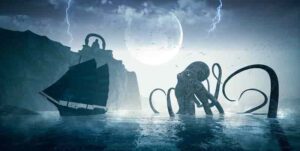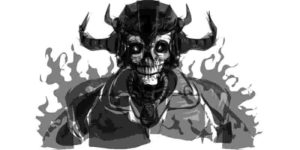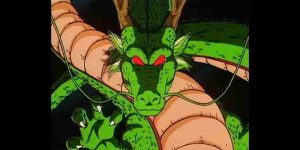Fairytales make up much of our creative diet as children growing up in the west. For many of us, this word brings back images of witches, monsters and fluttering pixies, but these tales have a much deeper ancestry with all kinds of variation.
Birthed from ancient Celtic, Germanic and Grekko/Roman lore, fairies, otherwise known as Fae, are supernatural or spiritual beings of nature. Though these elements are popularized in modern times as whimsical beings of the forest, the lore is rich with terrifying spirits and monsters as well. Stretching across Europe, tales of the otherworld brought intense scares that would make modern audiences shudder.
The top 12 scary fairy monsters and spirits are:
- Goblin
- Boggart
- Changelings
- The Dearg Due
- The Caorthannach
- Banshee
- Bean Nighe
- Fachan “Peg Leg Jack”
- Kelpies
- Nuckelavee
- LeanHaun-Shee
- Dullahan
Goblin
Goblins are monstrous kin to fairies, ranging from mischievous to diabolical. This creature is one of the most widespread among Europe and includes several subtypes. I could go on and on about all the different kinds of goblins, but let’s check out three of the most notorious examples.
Hobgoblin
Hobgoblins are small, brownie-like entities that lean toward the mischievous side of the evil spectrum.
Often found in homes and hearths, these little tricksters were once considered helpful. Like trickster beings from other cultures, they weren’t inherently bad in their origin. Some folktales use them as guides and helpers in the story structure. However, with the advent and spread of Christianity, the old beings gained a less welcoming reputation.
Redcap
The redcap is a murderous assassin, dipping his hat in the blood of his victims.
Known to stalk abandoned forts and castles along the Anglo-Scottish border, the redcap tends to dwell in places where great tyranny existed. He’s almost a ghost, haunting the area because of its evil aura.
It is described as being a short, thick old man with long teeth and fingers. His fingertips are armed in eagle talons and his bulbous eyes glow fiery red. Long, dirty hair falls to his shoulders. For some reason, he prefers to wear iron boots. His weapon of choice is the pikestaff, though I’m sure those eagle talons could do a number.
Erlking
The old, Scandinavian king of the elves, the Erlking was popularized in German Romantic works of later centuries. As you can imagine, this guy is a big deal to be called “king of the elves”. We’re not even talking about goblins—he rules the Fae.
Though he is in such a position of power with this Germanic folklore, you more likely need to watch out for his daughter. Within the lore, she likes to tempt men to their demise. One such story Elveskud, is a Scandinavian ballad in which a heroic figure Olav denies her and is cursed.
Related Posts:
Scariest Sea Monsters From World Mythologies
| Scariest Monsters from Japan
|
Boggarts
Uglier and often foul-tempered cousins to brownies and other beast-like Fae, boggarts take multiple forms and have a penchant for stealing children. Some are similar to brownies, except incredibly disgusting and annoying, wiping people’s faces with clammy hands while they sleep. Little jerks.
Other forms are more beast-like, as the Boggart of Longar Hede or the Boggart of Hackensall Hall. The first example was something fierce, harry and bizarre. With large, saucer-like eyes and a strange chain that sounds like the baying of hounds, this creature is a strange bugger. The “Hackensall Hall” version of the creature appeared as a giant horse—so there ya go, a giant horse fairy monster.
Another strange form these creatures can take is that of a satyr or other goat-like mythic beings. This may be due to Christian influence, attributing these old deities to demons and pagan spirits, as we’ll see arise in other fairy stories.
Changelings
Following the theme of child stealing, changelings are the Fae equivalent to Invasion of the Body Snatchers.
These shapeshifting creatures were thought to steal children, take their appearance and replace them. Essentially, they want to experience a genuine human baby lifestyle without all the fuss of a mortal life. The problem is, however, they don’t quite have the “act human” thing locked down. Whenever new parents suspect their child is acting out of character, the fear is that it was replaced
Sometimes these changelings are described as bug-eyed little people, sometimes they are described as elder fairies who are sick of being an adult. After eons of doing fairy stuff, some creatures want that good, old-fashioned human mom treatment. It would be kind of sweet if it weren’t so creepy.
The Dearg Due
Ever hear of a fairy vampire?
The Dearg Due is a creepy example of how similar monsters can be between cultures. As opposed to other vampires or striga legends, The Dearg Due is an individual being who arose from a tortured woman. As a young woman, she was offered to an older man, who cut her and locked her in a tower. Something about her porcelain skin, and the contrast of the crimson blood, drove him mad. But she wouldn’t live this way forever. Eventually, she ended her own life.
Well, some dark part of the universe wasn’t going to let that go. She rose from her grave transformed, thirsting for the blood of men. Now, she stalks English back roads at night, seeking her eternal revenge. Sometimes, this takes the form of a seductive young woman, sometimes it’s the bloodthirsty monster.
I kind of feel like she maybe could have taken her vengeance against the man who tortured her, but she’s adamant about killing every man she sees. Oh well, don’t guess I can blame her.
The Caorthannach
Caorthannach (pronounced queer-hawn-nock) is an ancient fairy enemy of St. Patrick and one bad mother. Probably topping the power charts of this list, she is claimed to be a fire-spitter, the mother of demons—including the Devil himself.
Her origin story is radical. When Earth was still forming, a swirling mass of vapors and rock, she was hatched from its molten core. From her birth, there was a need that wasn’t being met—she hungered and needed food for her demon spawn. So, she waited for us to come along, feeding our ancestors to her children (who often took the form of snakes).
In fact, the only way she was stopped was by Ireland’s patron saint, the famous St. Patrick. After a vision from Jesus, St. Patrick learned the location of Caorthannach’s lair beneath Lough Derg on Station Island. So, he climbed to the peak of Ox Mountain (Croagh Patrick) and prayed for the strength to beat her. God sent a whirlwind to eradicate her children but defeating her would take a little more from Patrick.
After days of battle, a long, thirsty chase and an ultimate, body-slamming banishment, our hero rose victorious, and the mother of demons was chased from the isle.
Banshee
A banshee is a Gaelic spirit, a ghostly woman who brings death omens. Therefore, seeing one spells certain doom.
Known throughout Irish fairy folklore, these spirits can be seen before tragedy occurs, often in conjunction with someone’s death. More often than not, this means doom for the witness. Along with the ghostly form, these spirits were known for their wailing—mourning your death before it comes to be.
Obviously, this is terrifying on multiple levels, and the banshee has been used effectively in popular culture through the ages. Sometimes, their moans and wails are more like ear-piercing screams. Other times, their portrayed in human form, cursed with doom sight.
The name itself (bean sí, baintsí, ben síde, baintsíde) translates from Old Irish to something like “woman of the fairy mound” or “fairy woman”. The connection to fairies is interesting, as some might assume a disconnect between what we think of fairies and ghosts. The banshee is somewhere in between, as is most Fae.
Bean-Nighe
Scottish Gaelic for “washerwoman” or “laundress”, bean-nighe is an otherworldly spirit and type of banshee. Therefore, you can imagine what happens when coming across one.
As you probably could have guessed, this is another ghostly woman crying over your demise. However, this time she’s doing laundry in a local body of water. Maybe it’s supposed to be your laundry, like it’s your own mom crying, which is disturbing in an oddly specific way.
What’s further interesting is the bean-nighe’s Scottish heritage. The two countries share Celtic ancestry, though they have grown into separate cultures. Legends and stories have evolved along with their respective cultures, sculpting unique differences like this. This spirit in particular even found its way to French storytellers known as Les Lavandières, The Midnight Washerwomen.
Fachan “Peg Leg Jack”
Coming out of Irish/Scottish folklore, the Fachan, otherwise known as “Peg Leg Jack”, is one terrifying fairy. It has one leg, one eye, one arm sprouting from its chest and a mane of black feathers. Apparently, this creature is so terrifying it was known to cause heart attacks.
One origin of this fairy creature comes from the way Celtic Seers worked their craft. As they would look into the otherworld, they would stand on one leg and close one eye. Could this have been translated into a demon figure as Christianity swept through Europe’s island kingdoms? Possibly. Either way, this guy has the coolest nickname and a uniquely horrible appearance.
Kelpies
The lochs of Scotland are murky and mysterious, holding legends of lurking monsters, spirits and kelpies.
However, one such spirit takes many forms, though it makes the water its home. The kelpie is known as a water horse that can shapeshift into a human. Almost every loch in the country has an associated kelpie story, especially the infamous Loch Ness (whose kelpie became more of a water dragon or dinosaur, I guess).
In horse form, it is known to lure children or curious people onto its back (horses were valuable). Then, the horror began. Once on the creature’s back, you would stick to it like glue. Now that you can’t get away, the creature simply walks back into the water, drowns you and has a nice meal.
The human form was used to lure prey in as well, although it couldn’t completely hide its hooves. These stories can be useful for warning children not to play too close to the water or young women to be suspicious of strangers. Even without monsters, people and bodies of water can be dangerous.
So, if you ever fantasized about riding the Loch Ness Monster’s back Aquaman style, you probably want to rethink that.
Nuckelavee
The nuckelavee seems to be a close cousin to the kelpie, potentially a combination of Scottish and Norse horrors. This could possibly the most grotesque member of the bad fairy family, often described as the torso of a man fused onto the back of a horse, all while skinless. It’s a creature of the sea, with fin like appendages on its hooves and long, dangling arms.
Originating as an Orcadian demon, this creature was thought to be the nastiest demon of Scotland’s Northern Isles. Its breath would wilt crops, sicken livestock, cause droughts and plagues, as if it were an entity of pestilence. As far as the terror scale goes, the inhabitants of these islands historically respected the monster.
To me, the nuckelavee seems like a kelpie on steroids. With the stories of riders “sticking” to these water horses and drowning, the imagery of a man fused with horse makes sense. I can imagine the fleshy part of the description comes from the idea of skin sticking to the creature in a goopy mess. Gross.
Leanan sídhe
The Leanan sídhe is known as the “Fairy Lover” and takes the form of a beautiful woman or muse to lure artistic men into devotional love.
So, what’s so bad about that?
The inspired man is signing away his life for enhanced creativity or inspiration. On top of cutting years out of his life, the end generally comes in madness. She’s like a drug and seems allegorical to substance abuse. W. B. Yeats described the spirit as almost vampiric, absorbing the artists life force as he created.
Maybe this fairy lover isn’t the scariest fairy on the list, but her end effect can be ugly. Oh, and there is a male version as well, so everyone can fall prey.
Dullahan
The Dullahan (dark man) is an Irish demonic fairy, a headless horseman with whip made of a human’s spine.
Like some of the other fairy beings in this list, this headless horseman appears across Europe and is an arbiter of doom. Sometimes, he’s searching for his lost head. Other times, he’s carrying his head along with him, calling out the names of his victims and killing them. He’s normally found riding the back of a horse, but sometimes appears in horse-and-carriage.
Washington Irving’s Sleepy Hollow is probably the most famous of these spirits in American folklore, with a nice jack-o-lantern-head twist. In Irving’s short story, the entity was a soldier who lost his head to a cannon ball during the Revolutionary War. His coconut probably exploded, so his fellow soldiers could only bring the headless body back. As the story goes, his spirit rises from Old Dutch Church of Sleepy Hollow, pissed off and in search of his head.
So, what do you think?
As rich and old as this lore is, there are surprising amounts of variation within this world we thought we knew. As Tolkien’s version of high fantasy took root in modern imaginations, it became easy to forget some of the vast amount of source material he pulled from. In all reality, Fae lore is only a small part of the whole in European supernatural tales.
Related Posts:
Best Grimdark Movies and Shows
| Most Famous Dragons in Movie and TV: What They Mean
|





